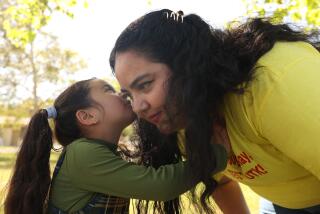Learning Keys to Success : Computer Software Helps Kids Tune Up Their Typing Skills
- Share via
Computers may have replaced typewriters, and technology-savvy youngsters may love to surf the Net. But one thing hasn’t changed: Students still hate learning to type.
“Keyboarding is something kids really don’t like to do that much. Like I hated typing school,” said Karen Kirby, who teaches after-school computer classes through her Irvine-based company, CompuQuest, (714) 261-0336 or klkirby@worldnet.att.net
But the ability to touch type is almost a necessity today, computer instructors say. Without it, valuable time is lost searching the keyboard. Typing school reports and papers can become tedious and time-consuming.
The solution? Make typing fun.
Today’s typing students still learn “home row,” but they aren’t tapping out lines such as “The quick brown fox jumped over the lazy dog” anymore. And the typing instructor is likely to be an animated character named Mario or Spooky or Mavis Beacon.
Yesterday’s high-school typing class has been replaced by computer programs geared to elementary-school youngsters. Typewriters have given way to computers that offer instant feedback, sound effects and game rewards.
Most public schools teach typing and beginning keyboarding in third or fourth grade. But those who want to get a jump on typing skills have a lot of options.
Parents can buy software such as “Mario Teaches Typing” ($39.99, Interplay), or they can sign their children up for classes such as Kirby’s or similar sessions offered through city recreation programs.
Programs with a lot of animation and sound are the favorites, Kirby said. Built-in games are the reward when students reach a certain goal.
“Sometimes they spend more time on the reward,” Kirby said, who believes students should never devote more than 10 or 15 minutes at a time to keyboarding.
At Futurekids Computer Learning Center, (714) 974-5437 or Futurekids@95net.com in Anaheim Hills, classes are available in computer literacy, word processing, spread sheets, desktop publishing and keyboarding. A six-hour keyboarding class, spread over a couple of days, covers typing, along with some word processing and graphics, for $99.
Most of the students at Futurekids have computers at home.
“Their parents want them to learn the skill so when they get on to really using the computer they don’t waste a lot of time with the hunt-and-peck method looking for keys,” director Debbie Lum said.
She and Kirby use computer programs such as Mario, “Kid’s Typing” ($44, Sierra) and “Mavis Beacon Typing” ($39.99, Mindscape).
Some public schools use a program that also offers games as rewards, said Steve Garretson, technology coordinator for Irvine Unified School District.
Students don’t really need to master word processing until they hit middle school, instructors say, though many begin typing reports and using the Internet for school research as early as fourth grade.
To build up typing speed, Kirby recommends using the Internet. Monitored chat rooms such as International Cool Kids are good because the competition to get in on the conversation encourages teens to type faster, she said. (Her daughter’s typing speed has soared to 40 words a minute through the chat rooms, Kirby said.)
How old is old enough to start typing? Generally, children don’t have the required hand span or the hand-eye coordination until they are 8 or 9 years old, instructors say. But computer exposure usually starts much earlier.
In Irvine Unified, kindergartners learn what a mouse is and how to work the enter keys on the computer. Second- and third-graders practice basic typing skills, and extra time is devoted to keyboarding in sixth grade, where students have to take a timed test and are expected to type 20 to 25 words a minute, Garretson said.
For children under 5, a better plan might be to sit down with them at the computer rather than trying to teach them typing per se, said John Lunsford of the Orange Coast IBM PC Users Group.
“Young children have boundless curiosity. Typing’s not really required. They just two-finger it until they get what they want,” he said.
For them, the computer is like a magic block set that can do anything, he said. “They are very willing to sit down and explore what those ‘everythings’ are.”
Will early typing create a generation of people with carpal tunnel syndrome--a condition that causes pain, tingling and numbness in the fingers and thumb? Lunsford said fear of developing carpal tunnel and other repetitive-motion problems is common among new computer users in the classes he teaches.
Some experts say those concerns are unfounded. Julio Taleisnik, professor of orthopedics at UCI and past president of the American Society for Surgery of the Hand, said there is no clearly established scientific link between typing and carpal tunnel syndrome.
And technology may make the question moot before it can be answered, as Lunsford sees it. Though typing is a requirement for computer users today, it might not be in 10 years. That’s because voice activation, which was initially disappointing, is coming along faster than expected, he said.
Soon, we may be talking to our computers.






